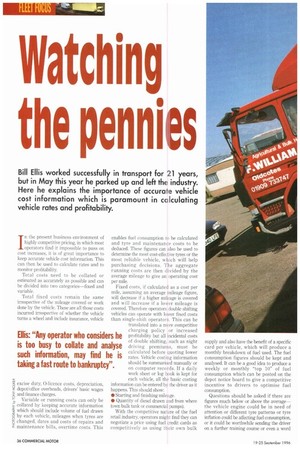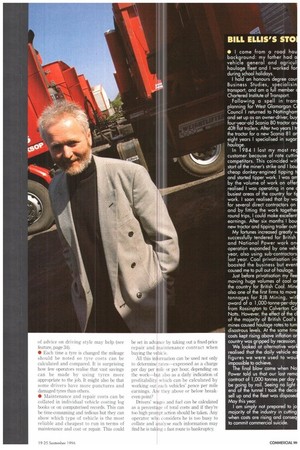Watching the pennies
Page 38

Page 39

If you've noticed an error in this article please click here to report it so we can fix it.
In the present business environment of highly competitive pricing, in which most operators find it impossible to pass on cost increases, it is of great importance to keep accurate vehicle cost information. This can then be used to calculate rates and to monitor profitability.
Total costs need to be collated or estimated as accurately as possible and can be divided into two categories—fixed and variable.
Total fixed costs remain the same irrespective of the mileage covered or work done by the vehicle. These are all those costs incurred irrespective of whether the vehicle turns a wheel and include insurance, vehicle
15. excise duty, 0-licence costs, depreciation, 2 depot/office overheads, drivers' basic wages gand finance charges.
Variable or running costs can only be collated by keeping accurate information which should include volume of fuel drawn
gby each vehicle, mileages when tyres are changed, dates and costs of repairs and
E. maintenance bills, overtime costs. This enables fuel consumption to be calculated and tyre and maintenance costs to be deduced. These figurt.s can also be used to determine the most cost-effective tyres or tht. most reliable vehicle, which will help purchasing decisions. The aggregate running costs are then divided by the average mileage to give an operating cost per mile.
Fixed costs, if calculated as a cost per mile, assuming an average mileage figure, will decrease if a higher mileage is covered and will increase if a lower mileage is covered. Therefore operators double shifting vehicles can operate with lower fixed costs than single-shift operators. This can be translated into a more competitive charging policy or increased profitability but all incidental costs of double shifting, such as night driving premiums, must be calculated before quoting lower rates. Vehicle costing information should be summarised manually or on computer records. If a daily work sheet or log book is kept for each vehicle, all the basic costing information can be entered by the driver as it happens. This should show: • Starting and finishing mileage.
• Quantity of diesel drawn and from where (own bulk tank or commercial pumps).
With the competitive nature of the fuel retail industry, operators might find they can negotiate a price using fuel credit cards as competitively as using their own bulk supply and also have the benefit of a specific card per vehicle, which will produce a monthly breakdown of fuel used. The fuel consumption figures should be kept and analysed. It can be a good idea to produce a weekly or monthly "top 10" of fuel consumption which can be posted on the depot notice board to give a competitive incentive to drivers to optimise fuel consumption.
Questions should be asked if there are figures much below or above the average— the vehicle engine could be in need of attention or different tyre patterns or tyre inflation could be affecting fuel consumption, or it could be worthwhile sending the driver on a further training course or even a word of advice on driving st le may help (see feature. page 34).
• Each time a tyre is changed the mileage should be noted so tyre costs can be calculated and compared. It is surprising how few operators realise that vast savings can be made by using tyres more appropriate to the job. It might also be that some drivers have more punctures and damaged tyres than others.
• Maintenance and repair costs can be collated in individual vehicle costing log books or on computerised records. This can be time-consuming and tedious but they can show which type of vehicle is the most reliable and cheapest to run in terms of maintenance and cost or repair. This could be set in advance by taking out a fixed-price repair and tnaintenance contract when buying the vithiele.
All this information can be used not only to determine rates—expressed as a charge per day per aide or per hour, depending on the work—bat also as a daily indication of profitability which can be calculated by working out each vehicles' pence per mile earnings. Aite they above or below breakeven point?
Drivers' wages and fuel can he calculated as a percentage of total costs and if they're 1., too high proi pt action should be taken. Any operator i.v .) considers he is too busy to collate and 4nalyse such information may find he is takjng a fast route to bankruptcy.








































































































